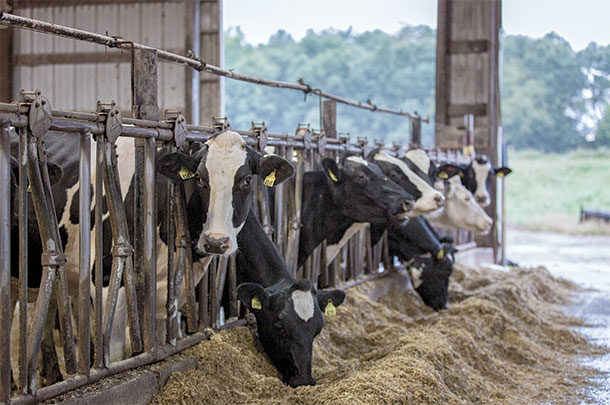Ketosis in dairy cattle has long been regarded as a problem for producers. Usually occurring during the transition between gestation and early lactation, ketosis is simply defined as higher-than-normal levels of blood ketones.
Accompanying signs of ketosis, however, can include inappetence, decreased milk production and loss of body condition.
Lactation and a cow’s opportunity to have a subsequent lactation depend on how successfully she adapts around the time she gives birth. Since cows with any health disorder around calving produce 7.2 kilograms (16 pounds) less milk per day during the first 20 days in milk (DIM), determining the root causes of health issues in your dairy herd is critical for achieving optimal milk production and profitability.
The process of ketosis
Ketosis is a metabolic condition in dairy cattle that occurs when ketone bodies – in particular, beta-hydroxybutyrates (BHBAs) – increase in the blood. A cow in ketosis starts making ketones when she doesn’t have enough glucose available. Ketosis is usually associated with intense milk production and negative energy balance. The immune system has a huge appetite for glucose. If a cow experiences immune activation* that requires a significant amount of glucose to trigger a response, she is much more likely to become ketotic. This is because energy and glucose are diverted to this process.
Challenging beliefs about dairy cow ketosis
For the past 50 years, people have associated ketosis with negative outcomes in cows and, over time, this association has morphed into causation. There’s an old saying: Correlation does not equal causation. I eat ice cream more in the summer, and I also get sunburned more in the summer. However, eating ice cream doesn’t cause my sunburn. These two things just happen to occur at the same time.
Researchers have looked at the issue of ketosis in dairy cows from different angles, which can be very helpful in getting us out of the rut of conventional thinking – namely that ketones cause immune suppression and cause cows to go off feed. Most of the body of evidence for ketosis is correlation, and we can’t always recreate negative outcomes if we infuse a cow with ketones. Think back to Koch’s third postulate: Inoculating a healthy individual with bacteria should recreate the disease. This helps us determine the bacteria that cause the disease. However, if you can’t recreate the negative outcomes, then you can’t confidently say what the cause of the disease is. The same principles should apply when thinking about dairy cows and ketosis.
Which type of ketosis do your cows have?
Stemming from concepts introduced by Dr. Gary Oetzel years ago, there may be two kinds of ketotic cows. The first has high levels of ketones but is also eating well, milks great, looks great and does not have a fever. For this cow, ketosis is just nature’s way of helping her get through the lactation period. She is using glucose for milk and relying on fat stores and ketones for her own tissue energy needs.
The second type of ketotic cow is one with high ketones but also has a reduced appetite, is not milking well, looks lethargic and droopy, has high insulin levels and may even be running a fever. This cow is sick and likely has lots of glucose going to the immune system which, in addition to poor eating and delayed onset of milking, is exacerbating the ketosis. Giving her more energy (usually in the form of a propylene glycol drench) may help in the short term, but it probably won’t fix the underlying problem. Somewhere, immune activation is putting the brakes on her appetite.
The current thinking is, “I have high levels of ketosis in my herd, and that is a problem.” However, our review challenges the industry to expand troubleshooting and take dry matter intake (DMI) and milk production into account when considering if ketosis really is a problem. There is likely an underlying root cause for this second type of “detrimental ketosis,” and this could vary on a cow-to-cow basis, but something besides milk production is creating a glucose shortage. We’re challenging the industry to look at ketosis as a symptom of a bigger problem. If we fix the root problem of ketosis rather than treat its symptoms, dairy cows – as well as dairy producers and dairy advisers – will be better off in the transition period.
If your ketotic cows are milking and eating fine, intervention may not be worth the trouble. Support them with a good, healthy diet with lots of glucose precursors and continue doing what you’re doing. Propionate converted to glucose is one of the most valuable fuels for a cow – it’s fuel for milk production and for the immune system.
If, on the other hand, you have high levels of ketosis in your herd and your cows are not eating or milking well, you need to assess what’s causing them to go off their feed. Reasons might include:
- Overcrowding
- Not delivering feed on time
- Hygiene problem in the feed
- Stress in the herd
- Heat stress
There are all kinds of stresses that could cause immune activation to begin. Work with your consultants and dairy management team to find the root cause of ketosis in your herd and fix the problem. In this situation, supporting the immune system through glucose precursors and a proper diet is still important, but it won’t fix the root cause, which could be related to health or management.
Tips for dairy producers and dairy nutritionists
Our hope is that our critical review of ketosis will encourage both dairy producers and dairy nutritionists to actively observe cows and think about potential root causes of stress before they lapse into ketosis. Here are some mitigation strategies for preventing detrimental ketosis:
- Prevent infection by keeping a clean environment
- Minimize stresses (including feed restriction, shipping, overcrowding, unpalatable feed and pen moves)
- Prevent rumen acidosis
- Maximize digestion prior to food reaching the large intestine (prevent hindgut acidosis)
- Use feed additives that have a positive effect on gut health
- Explore immunomodulatory strategies
Take the time to ensure cows have adequate dietary energy and nutrients to deal with a stress event, should it occur. Successfully executing these strategies can be a big step toward preventing immune activation, which can promote the health and productivity of dairy cows and improve operational profitability.
*In an immune activation, the body recognizes a foreign antigen or foreign substance where it shouldn’t be, most often on a mucosal surface such as the skin, gut, mammary gland, respiratory tract or uro-genital tract. If something unusual crosses that barrier surface, immune cells will respond to clear it.
References omitted but are available upon request. Click here to email an editor.







